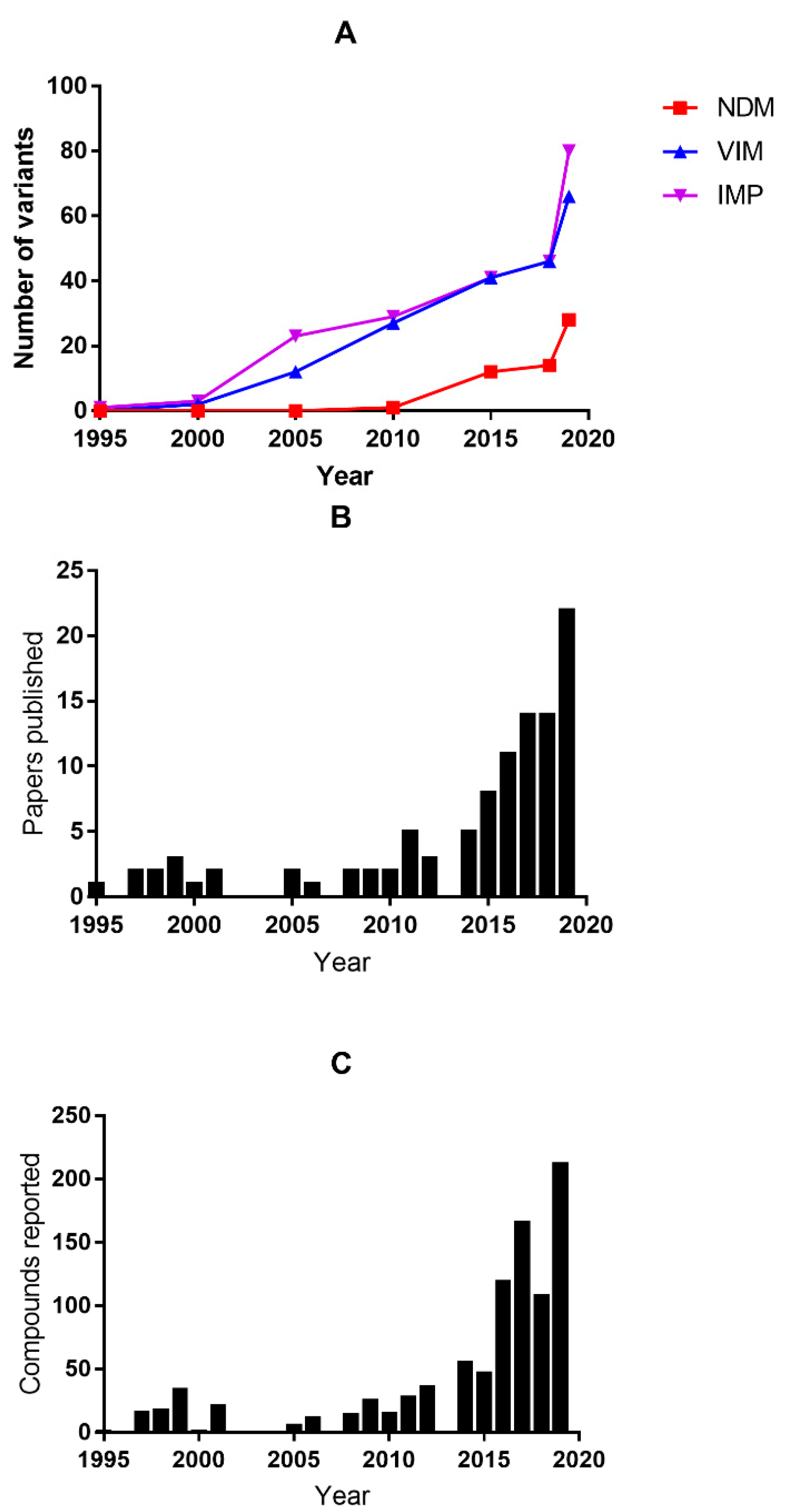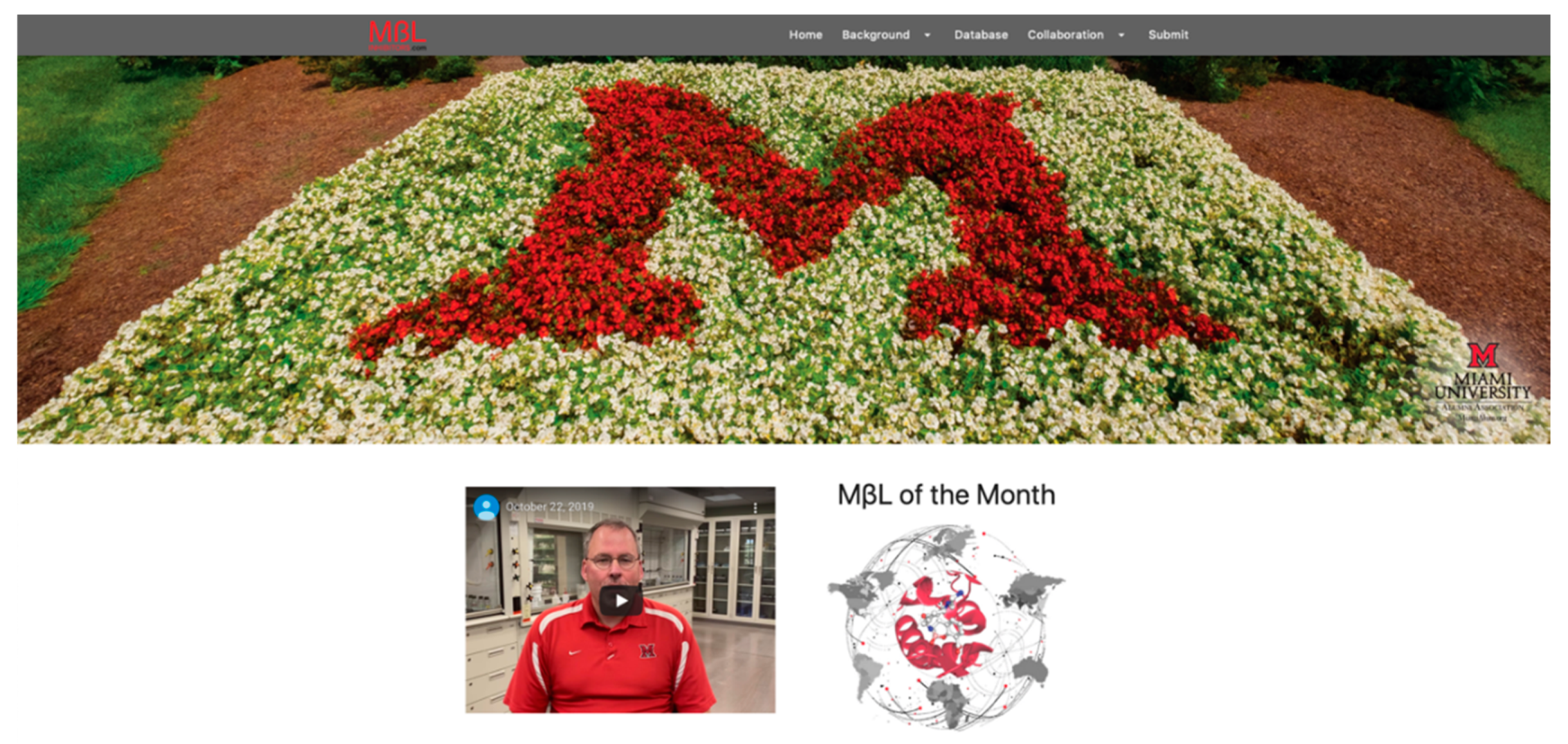MBLinhibitors.com, a Website Resource Offering Information and Expertise for the Continued Development of Metallo-β-Lactamase Inhibitors
Abstract
1. Introduction
2. Materials and Methods
2.1. Data Collection
2.2. Website Construction
3. Results
- “Background”: This menu leads to information about the various MBLs and MBL inhibitors included within the website.
- “Database”: This menu contains two functions; “Keyword Searching” and “Functional Group Filter.” The former allows visitors to search for a specific MBL inhibitor by chemical name, chemical formula, chemical structure, and/or SMILES format (Figure 3). The latter allows visitors to narrow their search results based on one or more functional groups that make up the inhibitor. Researchers can also search by specific MBL, by simply the name of the enzyme (NDM, VIM, etc.). Once a search has been completed, a list of the inhibitors, with the name and chemical formula, is shown (Figure 3). By clicking on the “View” button, the researcher can access a structure of the compound, name, SMILES, molecular weight, testing data (if known), and a link to a relevant publication.
- “Collaboration”: This menu currently contains a link to a description of Michael Crowder’s research lab, email address, link to website, and a description of techniques conducted in the lab on MBL inhibitors. To encourage collaboration in the MBL community, a second link is an invitation to other researchers to join the list of collaborators, with a fillable form to provide information. Researchers can elect to submit information that will be posted on MBLinhibitors.com.
- “Submit”: This function allows for researchers to submit new compounds to the database. Researchers can submit the chemical name, SMILES format (after this information is submitted, a structure is automatically drawn in the window), chemical formula, molecular weight, and publication information. After submission, the compound information will be reviewed and added to the mblinhibitor.com database.
4. Discussion
4.1. Data Sharing
4.2. Expertise Sharing
5. Conclusions
Author Contributions
Funding
Acknowledgments
Conflicts of Interest
References
- Fair, R.J.; Tor, Y. Antibiotics and bacterial resistance in the 21st century. Perspect. Med. Chem. 2014, 6, 25–64. [Google Scholar] [CrossRef] [PubMed]
- 2019 AR Threats Report. Available online: https://www.cdc.gov/drugresistance/biggest-threats.html (accessed on 13 March 2020).
- No Time to Wait: Securing the Future from Drug-Resistant Infections. Available online: https://www.who.int/antimicrobial-resistance/interagency-coordination-group/final-report/en/ (accessed on 13 March 2020).
- Chandel, A.K.; Rao, L.V.; Narasu, M.L.; Singh, O.V. The realm of penicillin G acylase in β-lactam antibiotics. Enzyme Microb. Technol. 2008, 42, 199–207. [Google Scholar] [CrossRef]
- Bush, K.; Bradford, P.A. β-Lactams and β-Lactamase Inhibitors: An Overview. Cold Spring Harb. Perspect. Med. 2016, 6. [Google Scholar] [CrossRef] [PubMed]
- Tooke, C.L.; Hinchliffe, P.; Bragginton, E.C.; Colenso, C.K.; Hirvonen, V.H.A.; Takebayashi, Y.; Spencer, J. β-Lactamases and β-Lactamase Inhibitors in the 21st Century. J. Mol. Biol. 2019, 431, 3472–3500. [Google Scholar] [CrossRef]
- Bush, K. Past and Present Perspectives on β-Lactamases. Antimicrob. Agents Chemother. 2018, 62, e01076-18. [Google Scholar] [CrossRef]
- Bonomo, R.A. β-Lactamases: A Focus on Current Challenges. Cold Spring Harb. Perspect. Med. 2017, 7. [Google Scholar] [CrossRef]
- Mojica, M.F.; Bonomo, R.A.; Fast, W. B1-Metallo-β-Lactamases: Where Do We Stand? Curr. Drug Targets 2016, 17, 1029–1050. [Google Scholar] [CrossRef]
- Papp-Wallace, K.M.; Bonomo, R.A. New β-Lactamase Inhibitors in the Clinic. Infect Dis. Clin. N. Am. 2016, 30, 441–464. [Google Scholar] [CrossRef]
- Shi, C.; Chen, J.; Kang, X.; Shen, X.; Lao, X.; Zheng, H. Approaches for the discovery of metallo-β-lactamase inhibitors: A review. Chem. Biol. Drug Des. 2019, 94, 1427–1440. [Google Scholar] [CrossRef]
- Rotondo, C.M.; Wright, G.D. Inhibitors of metallo-β-lactamases. Curr. Opin. Microbiol. 2017, 39, 96–105. [Google Scholar] [CrossRef]
- Karsisiotis, A.I.; Damblon, C.F.; Roberts, G.C. A variety of roles for versatile zinc in metallo-β-lactamases. Metallomics 2014, 6, 1181–1197. [Google Scholar] [CrossRef] [PubMed]
- Ishii, Y.; Eto, M.; Mano, Y.; Tateda, K.; Yamaguchi, K. In vitro potentiation of carbapenems with ME1071, a novel metallo-β-lactamase inhibitor, against metallo-β-lactamase- producing Pseudomonas aeruginosa clinical isolates. Antimicrob. Agents Chemother. 2010, 54, 3625–3629. [Google Scholar] [CrossRef] [PubMed]
- Livermore, D.M.; Mushtaq, S.; Morinaka, A.; Ida, T.; Maebashi, K.; Hope, R. Activity of carbapenems with ME1071 (disodium 2,3-diethylmaleate) against Enterobacteriaceae and Acinetobacter spp. with carbapenemases, including NDM enzymes. J. Antimicrob. Chemother 2012, 68, 153–158. [Google Scholar] [CrossRef] [PubMed]
- Krajnc, A.; Brem, J.; Hinchliffe, P.; Calvopiña, K.; Panduwawala, T.D.; Lang, P.A.; Kamps, J.J.A.G.; Tyrrell, J.M.; Widlake, E.; Saward, B.G.; et al. Bicyclic Boronate VNRX-5133 Inhibits Metallo- and Serine-β-Lactamases. J. Med. Chem. 2019, 62, 8544–8556. [Google Scholar] [CrossRef]
- Ju, L.C.; Cheng, Z.; Fast, W.; Bonomo, R.A.; Crowder, M.W. The Continuing Challenge of Metallo-β-Lactamase Inhibition: Mechanism Matters. Trends Pharmacol. Sci. 2018, 39, 635–647. [Google Scholar] [CrossRef] [PubMed]
- King, A.M.; Reid-Yu, S.A.; Wang, W.; King, D.T.; De Pascale, G.; Strynadka, N.C.; Walsh, T.R.; Coombes, B.K.; Wright, G.D. Aspergillomarasmine A overcomes metallo-β-lactamase antibiotic resistance. Nature 2014, 510, 503–506. [Google Scholar] [CrossRef] [PubMed]
- Bergstrom, A.; Katko, A.; Adkins, Z.; Hill, J.; Cheng, Z.; Burnett, M.; Yang, H.; Aitha, M.; Mehaffey, M.R.; Brodbelt, J.S.; et al. Probing the Interaction of Aspergillomarasmine A with Metallo-β-lactamases NDM-1, VIM-2, and IMP-7. ACS Infect. Dis. 2018, 4, 135–145. [Google Scholar] [CrossRef]
- Watanabe, M.; Iyobe, S.; Inoue, M.; Mitsuhashi, S. Transferable imipenem resistance in Pseudomonas aeruginosa. Antimicrob. Agents Chemother. 1991, 35, 147–151. [Google Scholar] [CrossRef]
- Lauretti, L.; Riccio, M.L.; Mazzariol, A.; Cornaglia, G.; Amicosante, G.; Fontana, R.; Rossolini, G.M. Cloning and characterization of bla(VIM), a new integron-borne metallo-β-lactamase gene from a Pseudomonas aeruginosa clinical isolate. Antimicrob. Agents Chemother. 1999, 43, 1584–1590. [Google Scholar] [CrossRef]
- Yong, D.; Toleman, M.A.; Giske, C.G.; Cho, H.S.; Sundman, K.; Lee, K.; Walsh, T.R. Characterization of a New Metallo-β-Lactamase Gene, blaNDM-1, and a Novel Erythromycin Esterase Gene Carried on a Unique Genetic Structure in Klebsiella pneumoniae Sequence Type 14 from India. Antimicrob. Agents Chemother. 2009, 53, 5046–5054. [Google Scholar] [CrossRef]
- Naas, T.; Oueslati, S.; Bonnin, R.A.; Dabos, M.L.; Zavala, A.; Dortet, L.; Retailleau, P.; Iorga, B.I. Beta-lactamase database (BLDB)–structure and function. J. Enzyme Inhib. Med. Chem. 2017, 32, 917–919. [Google Scholar] [CrossRef] [PubMed]
- Cheng, Z.; Thomas, P.W.; Ju, L.; Bergstrom, A.; Mason, K.; Clayton, D.; Miller, C.; Bethel, C.R.; VanPelt, J.; Tierney, D.L.; et al. Evolution of New Delhi metallo-β-lactamase (NDM) in the clinic: Effects of NDM mutations on stability, zinc affinity, and mono-zinc activity. J. Chem. Biol. 2018, 293, 12606–12618. [Google Scholar] [CrossRef] [PubMed]
- LaCuran, A.E.; Pegg, K.M.; Liu, E.M.; Bethel, C.R.; Ai, N.; Welsh, W.J.; Bonomo, R.A.; Oelschlaeger, P. Elucidating the Role of Residue 67 in IMP-Type Metallo-β-Lactamase Evolution. Antimicrob. Agents Chemother. 2015, 59, 7299–7307. [Google Scholar] [CrossRef] [PubMed]
- Makena, A.; Düzgün, A.Ö.; Brem, J.; McDonough, M.A.; Rydzik, A.M.; Abboud, M.I.; Saral, A.; Çiçek, A.Ç.; Sandalli, C.; Schofield, C.J. Comparison of Verona Integron-Borne Metallo-β-Lactamase (VIM) Variants Reveals Differences in Stability and Inhibition Profiles. Antimicrob. Agents Chemother. 2015, 60, 1377–1384. [Google Scholar] [CrossRef] [PubMed]
- Chen, A.Y.; Thomas, P.W.; Stewart, A.C.; Bergstrom, A.; Cheng, Z.; Miller, C.; Bethel, C.R.; Marshall, S.H.; Credille, C.V.; Riley, C.L.; et al. Dipicolinic Acid Derivatives as Inhibitors of New Delhi Metallo-β-lactamase-1. J. Med. Chem. 2017, 60, 7267–7283. [Google Scholar] [CrossRef]
- Chen, A.Y.; Thomas, P.W.; Cheng, Z.; Xu, N.Y.; Tierney, D.L.; Crowder, M.W.; Fast, W.; Cohen, S.M. Investigation of Dipicolinic Acid Isosteres for the Inhibition of Metallo-β-Lactamases. Chem. Med. Chem. 2019, 14, 1271–1282. [Google Scholar] [CrossRef]
- Kang, J.S.; Zhang, A.L.; Faheem, M.; Zhang, C.J.; Ai, N.; Buynak, J.D.; Welsh, W.J.; Oelschlaeger, P. Virtual Screening and Experimental Testing of B1 Metallo-β-lactamase Inhibitors. J. Chem. Inf. Model 2018, 58, 1902–1914. [Google Scholar] [CrossRef]
- Brindisi, M.; Brogi, S.; Giovani, S.; Gemma, S.; Lamponi, S.; De Luca, F.; Novellino, E.; Campiani, G.; Docquier, J.-D.; Butini, S. Targeting clinically-relevant metallo-β-lactamases: From high-throughput docking to broad-spectrum inhibitors. J. Enzyme Inhib. Med. Chem. 2016, 31, 98–109. [Google Scholar] [CrossRef]
- Shi, C.; Chen, J.; Xiao, B.; Kang, X.; Lao, X.; Zheng, H. Discovery of NDM-1 inhibitors from natural products. J. Glob. Antimicrob. Resist. 2019, 18, 80–87. [Google Scholar] [CrossRef]
- Truchon, J.F.; Bayly, C.I. Evaluating virtual screening methods: Good and bad metrics for the “early recognition” problem. J. Chem. Inf. Model 2007, 47, 488–508. [Google Scholar] [CrossRef]
- Fast, W.; Sutton, L.D. Metallo-β-lactamase: Inhibitors and reporter substrates. Biochim. Biophys. Acta Proteins Proteom. 2013, 1834, 1648–1659. [Google Scholar] [CrossRef] [PubMed]
- González, M.M.; Vila, A.J. An Elusive Task: A Clinically Useful Inhibitor of Metallo-β-Lactamases. In Zinc Enzyme Inhibitors: Enzymes from Microorganisms; Supuran, C.T., Capasso, C., Eds.; Springer International Publishing: Cham, Switzerland, 2017; pp. 1–34. [Google Scholar]
- PubMed. Available online: https://www.ncbi.nlm.nih.gov/pubmed/ (accessed on 13 March 2020).
- Google Scholar. Available online: https://scholar.google.com/ (accessed on 13 March 2020).
- Probst, D.; Reymond, J.L. SmilesDrawer: Parsing and Drawing SMILES-Encoded Molecular Structures Using Client-Side JavaScript. J. Chem. Inf. Model 2018, 58, 1–7. [Google Scholar] [CrossRef] [PubMed]
- DiMasi, J.A.; Grabowski, H.G.; Hansen, R.W. Innovation in the pharmaceutical industry: New estimates of R&D costs. J. Health Econ. 2016, 47, 20–33. [Google Scholar] [CrossRef] [PubMed]
- Smalley, E. AI-powered drug discovery captures pharma interest. Nat. Biotechnol. 2017, 35, 604–605. [Google Scholar] [CrossRef]
- Jamal, S.; Grover, A.; Grover, S. Machine Learning From Molecular Dynamics Trajectories to Predict Caspase-8 Inhibitors Against Alzheimer’s Disease. Front. Pharmacol. 2019, 10. [Google Scholar] [CrossRef] [PubMed]
- Zhavoronkov, A.; Ivanenkov, Y.A.; Aliper, A.; Veselov, M.S.; Aladinskiy, V.A.; Aladinskaya, A.V.; Terentiev, V.A.; Polykovskiy, D.A.; Kuznetsov, M.D.; Asadulaev, A.; et al. Deep learning enables rapid identification of potent DDR1 kinase inhibitors. Nat. Biotechnol. 2019, 37, 1038–1040. [Google Scholar] [CrossRef]



© 2020 by the authors. Licensee MDPI, Basel, Switzerland. This article is an open access article distributed under the terms and conditions of the Creative Commons Attribution (CC BY) license (http://creativecommons.org/licenses/by/4.0/).
Share and Cite
Cheng, Z.; Thomas, C.A.; Joyner, A.R.; Kimble, R.L.; Sturgill, A.M.; Tran, N.-Y.; Vulcan, M.R.; Klinsky, S.A.; Orea, D.J.; Platt, C.R.; et al. MBLinhibitors.com, a Website Resource Offering Information and Expertise for the Continued Development of Metallo-β-Lactamase Inhibitors. Biomolecules 2020, 10, 459. https://doi.org/10.3390/biom10030459
Cheng Z, Thomas CA, Joyner AR, Kimble RL, Sturgill AM, Tran N-Y, Vulcan MR, Klinsky SA, Orea DJ, Platt CR, et al. MBLinhibitors.com, a Website Resource Offering Information and Expertise for the Continued Development of Metallo-β-Lactamase Inhibitors. Biomolecules. 2020; 10(3):459. https://doi.org/10.3390/biom10030459
Chicago/Turabian StyleCheng, Zishuo, Caitlyn A. Thomas, Adam R. Joyner, Robert L. Kimble, Aidan M. Sturgill, Nhu-Y Tran, Maya R. Vulcan, Spencer A. Klinsky, Diego J. Orea, Cody R. Platt, and et al. 2020. "MBLinhibitors.com, a Website Resource Offering Information and Expertise for the Continued Development of Metallo-β-Lactamase Inhibitors" Biomolecules 10, no. 3: 459. https://doi.org/10.3390/biom10030459
APA StyleCheng, Z., Thomas, C. A., Joyner, A. R., Kimble, R. L., Sturgill, A. M., Tran, N.-Y., Vulcan, M. R., Klinsky, S. A., Orea, D. J., Platt, C. R., Cao, F., Li, B., Yang, Q., Yurkiewicz, C. J., Fast, W., & Crowder, M. W. (2020). MBLinhibitors.com, a Website Resource Offering Information and Expertise for the Continued Development of Metallo-β-Lactamase Inhibitors. Biomolecules, 10(3), 459. https://doi.org/10.3390/biom10030459




